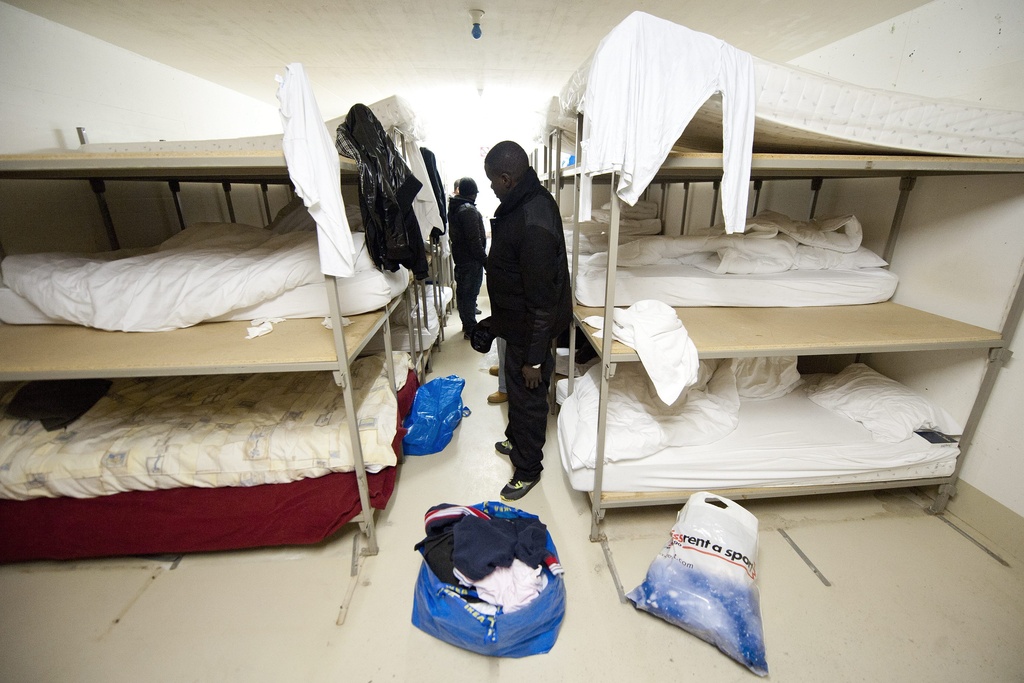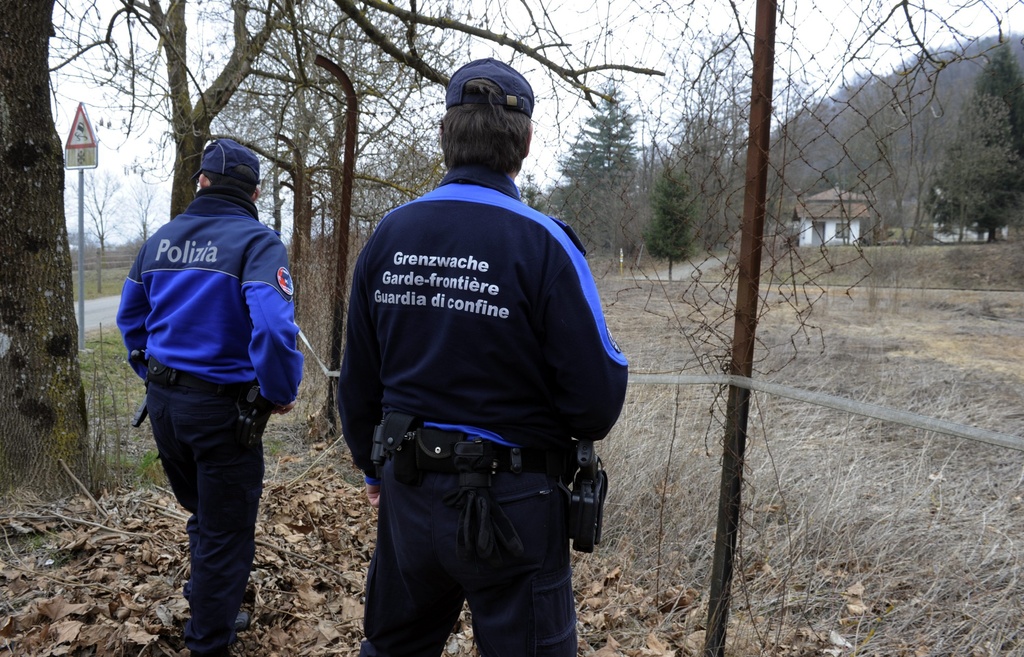Asylum seekers bunk down in emergency shelters

Under pressure from federal authorities to find housing for increasing numbers of asylum claimants, cantons are turning to emergency bunkers as a solution.
The issue came to a head this week with police in Neuchâtel forced to intervene when members of a group of 31 claimants refused to move from hostel housing to a bunker which had been opened to make way for new arrivals.
“It’s true that it’s a civil protection measure which by definition does not have windows, which has living conditions which are more about survival,” head of the Neuchâtel migration service Serge Gamma told swissinfo.ch.
“It’s the only place we could make available given the urgency of the situation.”
Federal authorities have estimated that events in North Africa and the Middle East could lead to an additional 200 to 700 claims being lodged in Switzerland per month. They have asked the cantons to be ready to receive up to 5,000 extra asylum seekers.
But statistics for April show the number of registered claims declined 20 per cent compared with March.
Asylum claims from countries where the political and security situation remains critical – Yemen, Libya, Syria – halved from 100 in March, to 48 in April. (see graphic)
Migration Office spokesman Michael Glauser told swissinfo.ch that given the evolving nature of events in North Africa and the Middle East, it is impossible to predict to what extent Switzerland may see an increase in asylum claims.
He added that for the moment at least, sending back rejected asylum seekers to countries such as Tunisia was not possible.
“These numbers of 200 to 700 people were set as a guide for organisational purposes for the cantons,” Glauser said. “We can say that in April there were fewer people who came but we can’t say if that’s a trend which is going to continue or not.”
Precedent
Gamma said it was not the first time the canton had been forced to open emergency bunkers to house asylum claimants.
He said Neuchâtel had used the bunkers in December 2008, and in the 1990s when the Kosovo War led to an influx of nearly 50,000 asylum seekers to Switzerland.
“Neuchâtel is not the only canton to use these centres while we try to find a solution in the longer term,” Gamma said.
“We cannot compare the two situations,” Glauser said. “We can only say that today there is not a crisis like in the 1990s.”
Distribution
The cantons are required to take responsibility for accommodating asylum claimants after a three month period during which they are housed in federal facilities.
Allocations are made by federal authorities according to the percentage of the Swiss population that lives in each canton – the bigger the canton in terms of population, the more people they will be asked to accommodate.
Head of the social welfare department for canton Fribourg, François Mollard, said the canton is preparing to increase housing capacity by up to 200 people from a normal capacity of 1,300.
Mollard has made a public appeal for landlords to make apartments available for housing asylum seekers, but said the canton is also examining the possibility of opening emergency shelters.
“In Fribourg there is not a bigger problem than elsewhere,” Mollard told swissinfo.ch. “The signals are red because in the federal lodging centres, the increase is real and points to the distributions which are going to follow.”
Glauser said federal authorities, which are responsible for examining and resolving claims, try as far as possible to do so within three months of the claim being registered.
“We want to give a clear signal to people who cannot stay here that they must leave,” Glauser said.
Conditions
Unlike in Australia, for example, where asylum claimants, including children, are subject to mandatory detention in prison-type facilities, asylum claimants in Switzerland are free to move about.
The Swiss Refugee Council notes that while asylum seekers do not have the legal right to choose their living quarters, the cantons are responsible for ensuring housing is “appropriate” for the people concerned.
“Particularly for people who have been traumatised, who may be claustrophobic, or who were imprisoned in their country of origin, these underground lodgings should be a last resort and an interim measure which should only last a few days,” the Refugee Council said in a statement.
Gamma said the group asked to move to the bunker was composed of single men, most of whom had been notified that their asylum claims had been rejected. He said the places made available in the hostel would be allocated to women and children.
“I can understand that for people who until now were lodged in a facility where they had a bedroom with two beds, where they could cook the food they wanted, that they would be outraged at their new conditions,” Gamma said.
“But they need to realise that for most of them, they should no longer be in Switzerland. It’s not total comfort, we are agreed, but they must make an effort to understand from their side.”
Notified of pending new arrivals, Neuchâtel migration service decided to move 31 asylum claimants from two hostels to an emergency bunker known as Bois-Jean-Droz on May 2 and 3.
Of the first group of 18 people, only one person agreed to stay at Bois-Jean-Droz upon arrival at the bunker. Unhappy with their new quarters, the rest collected their luggage and made their way independently back to the hostel, where they insisted they would stay.
Given the large number in the group, they could not be refused entry to the hostel and police were called to prevent the situation from further deteriorating, the Neuchâtel migration service said in a statement. The group spent the night in the hostel, with some forced to sleep in communal areas.
Those who refused to move to the bunker were restricted from entering local towns as a penalty. Serge Gamma, head of the migration service said that following their initial refusal, most people had afterward agreed to the move.
Federal authorities have established an expert committee to examine asylum procedures and accommodation issues in relation to evolving events in North Africa and the Middle East.
The committee has determined it prudent to commence preparations for a possible increase in claims. To that end, authorities have notified the cantons that they must make additional housing available.
Authorities are in the process of recruiting up to 40 new staff to handle the expected increase in asylum claims, and have increased the capacity of federal facilities used to house claimants. They have also raised the possibility of using army barracks to house people.
The government has emphasised the need to address issues at the source, intensifying discussions with Italy, where many migrants enter Europe. It has also made available SFr12 million ($14 million) in international aid, including the return of people to their countries of origin.
Switzerland receives an average of 1,300 asylum claims per month.
1,495 claims for asylum protection were lodged in April, compared with 1,874 in March.
Most claims in April were received from citizens of Eritrea, who lodged 376 claims. Tunisians were second, with 165 claims lodged, followed by Macedonians (127) and Nigeria (97).

In compliance with the JTI standards
More: SWI swissinfo.ch certified by the Journalism Trust Initiative





You can find an overview of ongoing debates with our journalists here. Please join us!
If you want to start a conversation about a topic raised in this article or want to report factual errors, email us at english@swissinfo.ch.